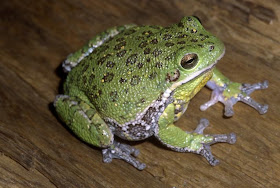Saturday, May 28, 2011
Species of the Day: Barking Tree Frog
Scientific Name: Hyla gratiosa
Family: Hylidae
Adult Size: 2 to 2 3/4 inches
Range: Found in the most part in the southeastern United States as far west as extreme eastern Louisiana and as far north as southeastern Virginia
Habitat: Barking tree frogs utilize both arboreal and terrestrial environments. During dry periods they will burrow into the ground or hide under surface cover to avoid dessication.
Barking tree frogs, one of the larger tree frog species found naturally in the US, are a colorful species, with a predominantly green dorsal coloration that is typically broken up with scattered dark spots. At night or during periods of stress, the color will change from green to a deep purple or brown. Males can be differentiated from females by the presence of a green or yellow throat.
Barking tree frogs can be kept quite easily in captivity, when provided with a few basic requirements. A variety of substrates will suit the needs of these frogs, including simple paper towels to more natural substrates, such as peat or green moss, ground coconut husks or a mixture of ground coconut husks and orchid bark. It is important to have a drainage layer at the bottom of the enclosure, which can be made using either large-grade pea-gravel or expanded clay pellets, and then covering this with fiberglass window screening to prevent the finer substrate from filling the gaps in the drainage layer. Suitable plants include philodendron, pothos, Aglaonema, dieffenbachia and other large-leaved, sturdy plants. It is also important to provide a large, clean water dish to allow them to soak regularly.
Crickets make a good staple food item when supplemented with meal worms and small silk moth larvae. Barking tree frogs have a voracious appetite and can become obese if over-fed. Gut loading food items with vegetables and commercial gut-loading food will provide a more nutritious meal for your frogs. Dusting food items with a vitamin/mineral supplement is also a good idea with this species, especially for younger animals still going through periods of rapid growth.

No comments:
Post a Comment